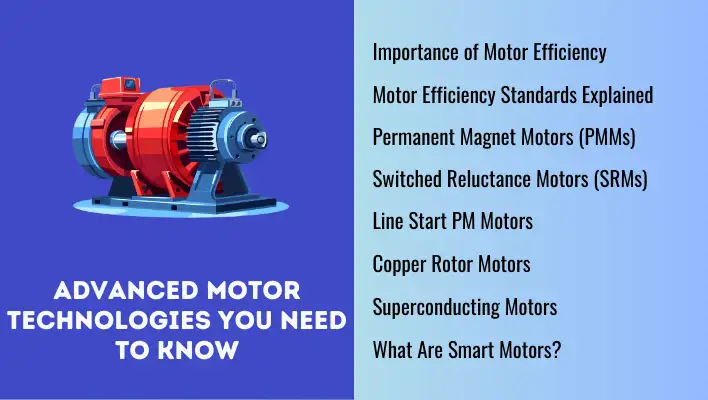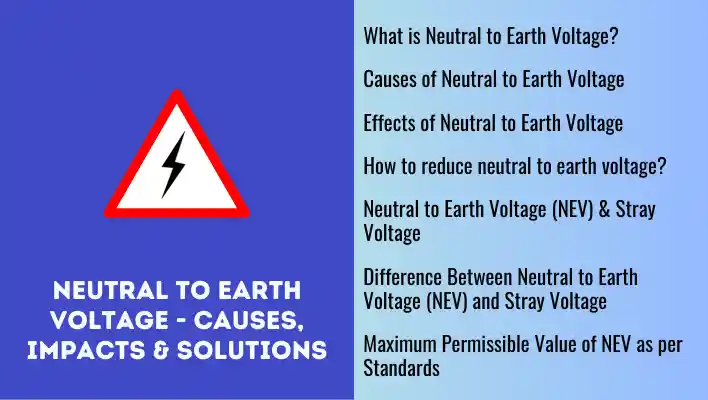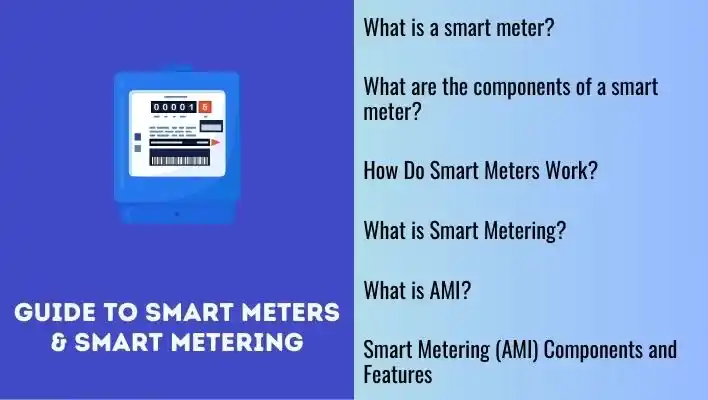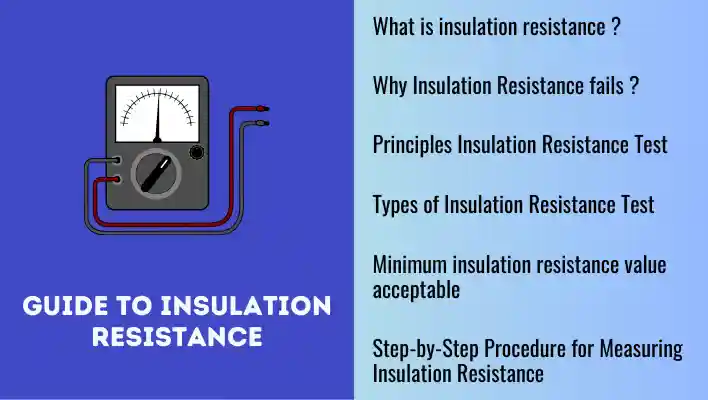Electric motor efficiency is a game-changer in reducing energy consumption and lowering greenhouse gas emissions. As industries move toward sustainability and electric vehicles (EVs) become more prevalent, the demand for high efficiency electric motors is skyrocketing.
With advancements in technology, we now have better materials, smarter designs, and innovative control systems that significantly improve motor efficiency. Investing in these technologies not only benefits businesses by cutting costs but also plays a crucial role in building a greener future.
In this post, we’ll explore the key breakthroughs making electric motors more efficient than ever before.
Smart Meters & Smart Metering | A Complete Guide
Importance of Motor Efficiency
Before moving on to the key technologies let us understand why motor efficiency is essential. There are several reasons, driven by environmental, economic, and technological factors:

- Energy Conservation and Sustainability
| Reduced Energy Consumption: Efficient motors consume less energy to perform the same tasks, which is crucial as global energy demand continues to rise. This helps conserve finite resources like fossil fuels. |
| Lower Carbon Emissions: Motors are widely used across industries, transportation, and appliances. Improving efficiency reduces greenhouse gas emissions, contributing to climate change mitigation and supporting global sustainability goals (e.g., the Paris Agreement). |
| Renewable Energy Integration: As the world shifts toward renewable energy sources (solar, wind, etc.), efficient motors ensure optimal energy use, reducing waste and maximizing the benefits of clean energy. |
- Economic Benefits
| Cost Savings: Efficient motors reduce operational costs by consuming less electricity, particularly for energy-intensive industries (e.g., manufacturing, HVAC systems). |
| Long-Term Investment: While efficient motors may have higher upfront costs, their long-term savings on energy bills and maintenance make them a cost-effective choice. |
| Competitiveness: Companies using efficient motors can lower production costs, enhancing their products’ competitiveness in the global market. |
- Regulatory and Policy Drivers
| Stricter Efficiency Standards: Governments worldwide are implementing stricter energy efficiency regulations for motors and appliances (e.g., the European Union’s Ecodesign Directive, U.S. Department of Energy standards). Motors must comply with these regulations to remain marketable. |
| Incentives for Green Technology: Many governments offer incentives, tax breaks, or subsidies for adopting energy-efficient technologies, encouraging the use of high-efficiency motors. |
- Technological Advancements
| Smart and Connected Systems: The rise of the Internet of Things (IoT) and smart technologies enables motors to operate more efficiently through real-time monitoring, predictive maintenance, and optimized performance. |
| Material Innovations: Advances in materials (e.g., lightweight composites, high-performance magnets) enable the design of motors with reduced energy losses and higher efficiency. |
| Electric Vehicles (EVs): The growing EV market demands highly efficient motors to extend battery life and reduce charging frequency, which is critical for electric transportation adoption. |
- Global Energy Demand
| Rising Population and Urbanization: As the global population grows and urbanizes, the demand for energy-intensive applications (e.g., transportation, HVAC, industrial automation) will increase. Efficient motors are vital to meet this demand without overburdening energy infrastructure. |
| Energy Security: Reducing energy waste through efficient motors enhances energy security by decreasing dependence on imported energy resources. |
- Environmental and Social Responsibility
| Corporate Social Responsibility (CSR): Companies are increasingly adopting sustainable practices to meet consumer and investor expectations. Using efficient motors aligns with CSR goals and enhances brand reputation. |
| Public Awareness: Consumers are becoming more environmentally conscious, driving demand for energy-efficient products, including motors in appliances, vehicles, and industrial equipment. |
- Future-Proofing
| Adaptability to Emerging Technologies: Efficient motors are better suited to integrate with emerging technologies like AI, automation, and renewable energy systems, ensuring they remain relevant in a rapidly evolving technological landscape. |
| Resource Scarcity: As raw materials become scarcer, efficient motors reduce the need for excessive resource extraction and processing, contributing to a circular economy. |
Neutral to Earth Voltage (NEV) | Causes, Impacts & Solutions
Motor Efficiency Standards Explained
What Are Motor Efficiency Standards?
To ensure consistency and promote energy savings, organizations worldwide have established standards to classify motor efficiency. These standards help manufacturers, governments, and consumers understand how well a motor converts electrical energy into mechanical energy, minimizing energy loss as heat.
The International Electrotechnical Commission (IEC) is a leading global organization that has developed widely accepted standards for motor efficiency. These standards classify motors into different efficiency levels, making it easier to compare and choose the right motor for specific applications.
Global Motor Efficiency Standards
Motor efficiency classifications are set by international and regional organizations to ensure consistency and encourage energy savings. The two most commonly used standards are:
IEC Efficiency Classes (IE Standards)

The IEC introduced the IE classification to standardize motor efficiency levels globally. These standards apply to low-voltage induction motors up to 1000 kW, helping industries choose energy-efficient motors based on a structured ranking system.
The IEC 60034-30-1 standard (last updated in 2014) defines four efficiency classes:
| IE1 (International efficiency – 1) | Standard Efficiency | The least efficient classification. |
| IE2 (International efficiency – 2) | High Efficiency | Improved efficiency compared to IE1. |
| IE3 (International efficiency – 3) | Premium Efficiency | Significant reduction in energy losses. |
| IE4 (International efficiency – 4) | Super Premium Efficiency | The highest efficiency level currently available. |
| IE5 (International efficiency – 5) | Still in drafting stage | Not yet available for commercial use. |
Each step up in the IE classification reduces energy losses by approximately 18% compared to the previous level.

The upcoming IE5 standard aims for an additional 20% reduction in energy losses compared to IE4, further improving energy savings. However, IE5 is still in the drafting phase and is not yet available for commercial use.
Key Features of IEC Efficiency Standards
- Covers single-speed motors with 2, 4, 6, or 8 poles.
- Applies to motors with power ratings from 0.12 kW to 1000 kW.
- Includes motors operating at 50Hz and 60Hz frequencies.
- Designed for ambient temperatures between -20°C and +60°C, and altitudes up to 4,000m.
Exemptions from IEC Efficiency Standards
Some motors are excluded from these standards due to their specialized functions or testing limitations. Exemptions include:
- Multi-speed motors or those with 10 or more poles.
- Motors integrated into machines (e.g., pumps, fans, compressors) that cannot be tested separately.
- Brake motors where the braking system is an internal part of the motor and cannot be tested independently.
- Submersible motors and smoke extraction motors operating at temperatures above 400°C.
North American NEMA Standards
In North America, the National Electrical Manufacturers Association (NEMA) defines motor efficiency standards, which align closely with the IEC system but currently only reach the equivalent of IE3 efficiency levels.
CEMEP EFF Classification (Europe-Specific)
Before the adoption of IEC standards, the European Committee of Manufacturers of Electrical Machines and Power Electronics (CEMEP) established the EFF classification for motor efficiency. This classification was widely used but expired in 2011 and has since been replaced by the IEC IE classification.
- EFF1: Most efficient (similar to IE2).
- EFF2: Moderate efficiency.
- EFF3: Least efficient.
All these standards help consumers make informed decisions and drive innovation in motor technology. As we look to the future, the introduction of IE5 motors promises even greater energy savings, further solidifying the role of efficient motors in a sustainable world.
Guide to Insulation Resistance | Explained in Simple Terms
Advanced Technologies Enhancing Motor Efficiency
With the growing emphasis on energy conservation and sustainability, advancements in electric motor efficiency have become a focal point for researchers and engineers. Below, we’ll explore the latest technologies and innovations revolutionizing motor efficiency, making them more powerful, compact, and energy-efficient.
Permanent Magnet Synchronous Motors (PMSM)
PMSM are at the forefront of motor technology, offering superior performance, compact designs, and exceptional energy efficiency compared to traditional induction motors.
These motors feature permanent magnets embedded in or mounted on the rotor, eliminating the need for external magnetization. This results in reduced energy losses, significantly improving motor efficiency.

What Makes PM Motors Different?
Unlike three-phase induction motors, PM motors are synchronous, meaning their rotor and stator rotate at the same speed without any slip, ensuring smoother operation and higher efficiency, especially at reduced speeds. Induction motors, in contrast, experience slip, which leads to energy losses and lower efficiency.
Applications of PM Motors
- Electric Vehicles (EVs): Due to their high torque, lightweight, and low inertia, they are ideal for EV hub motor drives.
- Industrial Machinery: Used in adjustable-speed pumps, fans, compressors, conveyors, etc.
- Renewable Energy: Utilized in winders and regenerative elevator drives.
- Consumer Electronics: Small devices and appliances benefit from their compactness and high efficiency.
| Advantages | Challenges |
| Higher efficiency at full and partial loads | Higher initial cost due to reliance on rare-earth magnets |
| Excellent torque-speed control | Requires a controller for speed and torque regulation |
| Longer lifespan | |
| Quiet operation | |
| Low maintenance |
Switched Reluctance Motors (SRMs)
Switched Reluctance Motors offer a cost-effective, robust alternative to traditional motors. They are used in industrial applications where reliability and high efficiency are essential.

What Are SRMs?
SRMs operate on reluctance force, which arises from variations in magnetic reluctance as the rotor moves.
The rotor is essentially a shaped piece of iron, and the SR motor design takes advantage of the fact that the forces exerted by a magnetic field on the rotor iron can be significantly stronger than those on the current-carrying conductors.
SRMs cannot operate with a standard variable frequency drive (VFD) like conventional AC induction motors so they require a specialized power converter.
Efficiency of SRMs
SRMs achieve high efficiency by leveraging the concept of magnetic reluctance. The rotor’s specially designed cutouts guide magnetic field lines, producing torque with minimal energy loss.
This design allows SRMs to achieve efficiency levels ranging from IE2 to IE4, depending on the power level. For instance, at power levels above 11 kW, SRMs can reach IE4 efficiency, which is considered super premium.
Applications of SRMs
- High-speed pumps, blowers, and compressors
- Low-speed, high-torque machinery
- HVAC systems, centrifuges, reverse osmosis pumps
| Advantages | Challenges |
| High efficiency and rugged design. | Ripple torque and vibration causing noise. |
| Low maintenance. | Requires a specialized controller. |
| Variable speed and high torque. | Efficiency dependent on duty cycle. |
| Durability and thermal resilience. |
Line Start PM Motors
Line Start Permanent Magnet Motors combine the benefits of induction and PM motors, providing high efficiency without needing a controller.
What Are Line Start PM Motors?
Line Start PM Motors are a hybrid design that combines the simplicity of a conventional induction motor with the high efficiency of a permanent magnet motor. Here’s how they function:
- Stator Design: The stator is identical to that of a standard three-phase induction motor, featuring a distributed winding.
- Rotor Design: The rotor sets these motors apart. It includes an aluminum cage, similar to an induction motor, along with embedded permanent magnets. This design enables direct startup from the power line without requiring a controller.
Once the motor reaches its operating speed, it synchronizes with the power frequency and runs at a fixed synchronous speed, regardless of the load. This synchronization ensures exceptional efficiency, often achieving super-premium levels (IE3 to IE4).
| Advantages | Challenges |
| High efficiency with no rotor cage resistance. | High starting torque. |
| No controller required for startup. | Susceptibility to synchronization issues with voltage or load changes. |
| Compatible with existing motor systems. | Higher initial cost compared to standard motors. |
Copper Rotor Motors
Copper rotor motors are an exciting advancement in electric motor technology, offering a significant improvement in motor efficiency. As rotor losses contribute to about 25% of the total losses in a motor, enhancing the rotor material plays a crucial role in optimizing overall performance.
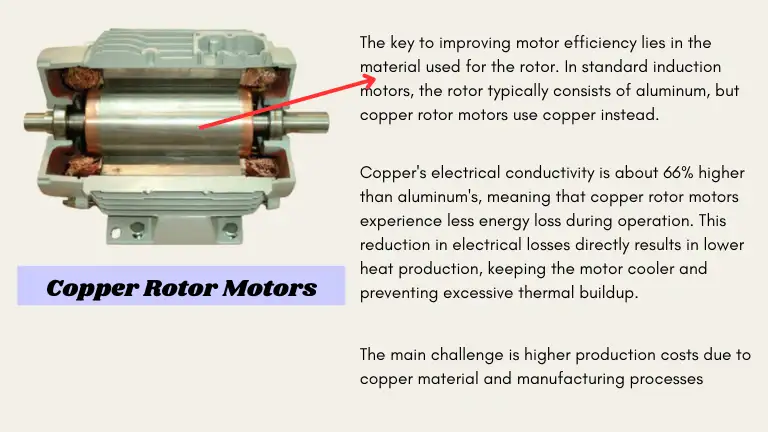
How Copper Rotor Motors Improve Motor Efficiency
The key to improving motor efficiency lies in the material used for the rotor. In standard induction motors, the rotor typically consists of aluminum, but copper rotor motors use copper instead. This change brings a considerable reduction in the resistance or I²R losses in the rotor conductor bars.
Copper’s electrical conductivity is about 66% higher than aluminum’s, meaning that copper rotor motors experience less energy loss during operation. This reduction in electrical losses directly results in lower heat production, keeping the motor cooler and preventing excessive thermal buildup.
With less heat, the motor can operate more efficiently, and cooling requirements decrease. This allows for the use of a smaller cooling fan, which reduces friction and windage losses, further improving efficiency. Copper rotor motors also exhibit remarkably low stray load losses, making them even more efficient in various applications.
| Advantages | Challenges |
| Reduced rotor losses and lower operating temperatures. | Higher production costs due to copper material and manufacturing processes. |
| Improved motor performance with better efficiency ratings. | |
| Lower maintenance due to better heat management. |
Superconducting Motors
Superconducting motors represent a major leap forward in the world of electric motor technology. These motors utilize superconducting materials for their windings, offering significant improvements in the efficiency of motors compared to traditional designs. But what exactly makes superconducting motors so special?
What Are Superconducting Motors?
Superconducting motors are a type of electric motor that uses superconducting materials in their windings instead of traditional copper or aluminum.
Superconductivity is a phenomenon where certain materials, when cooled to extremely low temperatures, lose all electrical resistance. This means electricity can flow through them without any energy loss, making them ideal for high-efficiency applications.
In superconducting motors, the rotor, stator, or both are made from these specialized materials. The absence of electrical resistance allows these motors to operate with minimal energy loss, resulting in significantly higher efficiency and power density compared to conventional motors.
How Do Superconducting Motors Work?
Superconducting Materials
The heart of a superconducting motor lies in its materials. High-temperature superconductors (HTS), such as yttrium barium copper oxide (YBCO) or magnesium diboride (MgB₂), are commonly used. These materials only exhibit superconductivity when cooled below a specific critical temperature, often below -100°C. To maintain this state, a cooling system is integrated into the motor.
Magnetic Field Generation
Superconducting materials can generate incredibly strong magnetic fields without significant heat loss. In a motor, these fields interact with other magnetic fields (from conventional magnets or additional superconducting coils) to produce rotational motion. This interaction is what drives the motor.
Cooling System
Since superconductivity requires extremely low temperatures, superconducting motors are equipped with a cryogenic cooling system. Liquid nitrogen or liquid helium is typically used to maintain the necessary conditions. While this cooling system adds complexity, the energy savings from eliminating electrical resistance often outweigh the cooling costs.
Stator and Rotor Design
In superconducting motors, the rotor or stator (or both) is made using superconducting coils. These coils are wound with superconducting wires and generate powerful magnetic fields when an electric current passes through them. The interaction between these fields and the stator creates the rotational force needed to drive the motor.
Why Are Superconducting Motors More Efficient?
Superconducting motors stand out for their exceptional efficiency, often exceeding 99%. Here’s why:
| Zero Electrical Resistance: The absence of resistance in superconducting materials eliminates energy loss in the form of heat, a major drawback in traditional copper or aluminum windings. |
| Higher Current Density: Superconductors can carry much higher currents than conventional conductors, allowing for more compact and powerful motors. |
| Reduced Cooling Losses: While cooling is required, the energy lost to heat is minimal compared to traditional motors, where resistance heating is a significant issue. |
| Increased Power Density: These motors can generate stronger magnetic fields in smaller volumes, making them ideal for applications where size and weight matter, such as electric aircraft. |
Challenges in Superconducting Motor Efficiency
While superconducting motors offer remarkable efficiency, they are not without challenges:
| Cooling Costs: The energy required to maintain the low temperatures for superconductivity can impact the overall system efficiency. |
| Material and Manufacturing Costs: High-temperature superconductors are expensive, and the manufacturing process is complex, making these motors costly to produce. |
| Design Complexity: Balancing mechanical, electrical, and thermal characteristics requires advanced engineering and specialized equipment. |
Applications of Superconducting Motors
Superconducting motors are being explored for a wide range of applications due to their high efficiency and power density:
| Electric Aircraft: Their lightweight design and high efficiency make them ideal for next-generation electric aviation. |
| High-Speed Trains: Superconducting motors can enhance the performance of maglev (magnetic levitation) trains. |
| Power Generation: They are being used in large-scale power plants to generate electricity more efficiently. |
| Medical Equipment: Superconducting magnets are already used in MRI machines, and these motors could revolutionize robotic surgery and other medical technologies. |
Comparing Efficiency: Traditional vs. Superconducting Motors
| Traditional Motors: Typically operate at 85-95% efficiency, depending on design and application. |
| Superconducting Motors: Can achieve efficiencies of 99% or higher, particularly in terms of electrical losses. |
Smart Motors
Electric motor efficiency has significantly improved with the introduction of smart motors integrated with IoT technology. These advanced motors optimize performance, minimize energy consumption, and provide real-time monitoring, making them an essential innovation for industries like manufacturing, HVAC systems, and electric vehicles.
What Are Smart Motors?
Smart motors are electric motors equipped with built-in sensors, micro-controllers, and communication interfaces that enhance efficiency and reliability.
Unlike traditional motors, smart motors continuously analyze their operational conditions, adjust performance accordingly, and provide predictive maintenance insights.
The adoption of smart motors with IoT integration is a game-changer for industries looking to improve electric motor efficiency. These motors not only enhance performance but also reduce maintenance costs and extend equipment lifespan.
As technology continues to evolve, smart motors will play a crucial role in achieving energy-efficient and sustainable industrial operations.
How Do Smart Motors Work?
Smart motors integrate intelligent components that allow them to operate efficiently:
| Embedded Sensors – Monitor critical parameters such as temperature, vibration, torque, and speed. |
| Micro-controllers – Process sensor data to optimize motor performance in real time. |
| Communication Interfaces – Enable remote monitoring and control through IoT, Bluetooth, or industrial protocols (e.g., Modbus, CAN, Ethernet). |
| Predictive Maintenance – Detects early signs of wear and tear, preventing unexpected failures and reducing downtime. |
| Adaptive Control – Adjusts speed, torque, and power consumption based on workload, ensuring optimal efficiency. |
Efficiency Levels of Smart Motors
Smart motors outperform conventional motors by reducing energy waste and optimizing power consumption. Their efficiency depends on the motor type and application:
| General Industrial Smart Motors – 90-98% efficiency (compared to 80-90% for standard motors). |
| Permanent Magnet Synchronous Motors (PMSM) – Up to 98% efficiency. |
| Brushless DC Motors (BLDC) – 85-95% efficiency. |
| Servo Motors – 85-95% efficiency with precise motion control. |
By implementing smart motors, industries can lower operational costs, enhance equipment reliability, and contribute to sustainability by reducing energy consumption.
The Role of IoT in Enhancing Motor Efficiency
The integration of IoT technology with smart motors has revolutionized motor efficiency by enabling real-time data analytics and predictive maintenance. IoT enabled motors continuously monitor operational parameters and alert users to potential failures before they happen.
Key IoT Features Improving Motor Efficiency
| Vibration Sensors – Detect abnormal vibrations, indicating potential issues like misalignment or bearing failure. |
| Temperature Monitors – Alert operators when components approach critical temperature thresholds, preventing overheating and motor failure. |
| Cloud-Based Monitoring – Enables remote access to performance data, allowing operators to make informed decisions and optimize energy usage. |
Conclusion
The advancements in electric motor efficiency discussed in this post highlight the transformative impact of technology on energy conservation, cost reduction, and environmental sustainability.
As industries, governments, and consumers increasingly prioritize energy-efficient solutions, the demand for high-performance electric motors will continue to rise.
The path forward is clear: embracing electric motor efficiency is not just an economic decision but an environmental imperative.
By continuing to invest in research, innovation, and policy-driven initiatives, we can accelerate the transition toward a more sustainable, energy-efficient world.
Related Posts

